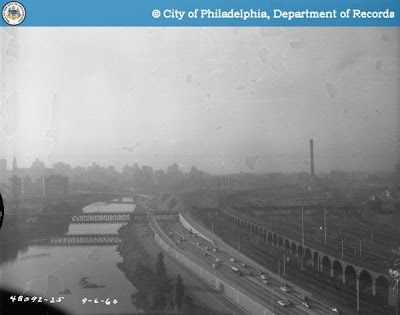Spanning the Schuylkill River at Chestnut Street
 |
| Could have called it Spiderman Bridge |
This beast was so cool-looking that it gave reason for people to walk down the Schuylkill Banks before they ever had a trail or a highway running along them. The motherfucker took nine years of preparation and five years to build.
It all started in 1852. The only bridges across the Schuykill that were any damn good were at Market Street and Spring Garden Street. Every other one was either a shitbag pontoon bridge or some crappy covered bridge that would get washed away in any bad storm. The two real bridges were getting to be over-run with traffic. On March 27th of that year, and act passed stating that there should be bridges built at Callowhill and Chestnut Streets, the streets next to the current bridges, to alleviate some of that shitty traffic.
Enter all-around badass Strickland Kneass, the city's chief engineer. He came up with an idea for a bridge at Chestnut Street that would blow the fucking socks off any other in the WORLD. While people once loved the high-tech offerings of the Wire Bridge at Fairmount, its day was over. A new bridge would be needed to impress engineering ninjas everywhere. Once Kneass presented his plan in 1857 (after at least two more Acts demanding it were passed), people went apeshit over everything about it.. except for the cost. Half a million bones.
In the 1850's, half a million dollars was like saying a billion bajillion dollars today. After three years, some money was thrown in by local railroad interests so the thing could just get built already. Construction began in 1860.
Then, right as preparations for the construction began, the city's Master Warden, Charles S. Wayne, said "Fuck you, Kneass! This is my river!! You're not putting coffer dams in the middle of it, you dirty bastard!!", and sued the fuck out of the city. His case was dismissed the day it went to trial. Ends up that the Master Warden's jurisdiction ends at the shoreline. The dumbass Chief Warden almost stopped this project from ever happening. After five long years of construction, the bridge finally opened on June 23rd, 1866... and it wasn't even really done yet.
 |
Once open, this became THE way across the Schuylkill. Philadelphia's newest bridge became the envy of the world and was referred to as a great specimen of design and engineering. As the decades passed, the bridge stayed in continuous use with very little maintenance. In 1911, the approaches to be bridge were widened to support the shitload of people that were all about crossing this bridge, despite the fact that newer alternate bridges had been built up and down the river by this point.
In 1956, ninety years after the bridge opened, a proposal to take it down and replace it with a FUCKING HIGHWAY OVERPASS-looking piece of dogshit was floated around. Ends up the western abutment was standing in the way of progress.
 | |
| From this... |
 |
| to THIS. What a travesty. |
 |
| Look at that shit... and you can see this week's Mystery Building on the left! |
 |
| Here's the bridge at age 89. Just a reminder of when shit looked good. |
-GroJLart, King of Philadelphia and France










































